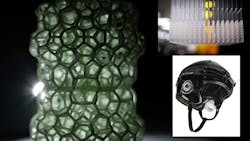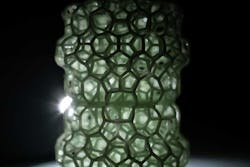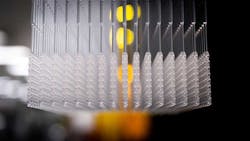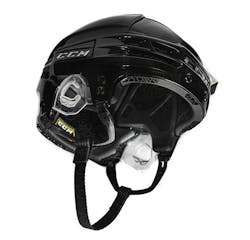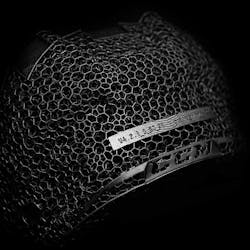Lattice Design Enables 3D-Printed Nasal Swab Production
At a Glance:
- A national shortage of nasopharyngeal testing swabs motivated the additive manufacturing community to demonstrate its ability “to design fast, trade fast and put it into production very fast.”
- Hardik Kabaria, director of software engineering, Carbon, developed a viable swab prototype within a couple of hours.
- Carbon Design Engine, a lattice design generator, is being democratized so users can pay back through feedback.
Manufacturing disruptions due to stay-at-home orders last year exposed weaknesses in the supply chain that brought manufacturing to a standstill. In the middle of the mayhem, manufacturing communities banded together to bridge gaps in resilience strategies. Some would turn to additive manufacturing for tactical measures in meeting supply chain resilience.
Consider the nasopharyngeal swab shortage. Consisting of a plastic shaft and a swab head that is typically covered with an absorbing material such as cotton, polyester or nylon, these narrow sticks were in short supply and held up coronavirus testing. It would take both ingenuity and the experience of working with lattice technology to propel a new swab design to market and remedy the scarcity.
“In 3D printing we always think about different ways that the technology we have can benefit not just the society, but help people create parts at the right time, when it’s needed,” said Hardik Kabaria, director of software engineering for the 3D printing technology company Carbon.
But it wasn’t until the news of the swab shortage was in circulation that the 3D community jumped in, acknowledged Kabaria, who viewed the situation as a challenge that 3D printing technology should be able to solve. “This is what we have imagined our technology to be useful for,” he said.
The nasal swab was not an item 3D technology would conventionally print, pointed out Kabaria, because they are relatively cheap and easy to manufacture by conventional methods. The 3D printing intervention was needed, he said, because “the supply chain broke.”
For Kabaria, the medical device shortage created the “right problem statement” and was an incentive for the additive manufacturing community to demonstrate that it was able “to design fast, trade fast and put it into production very fast.”
At a conceptual level, Kabaria was motivated to apply his knowledge and the technology Carbon had developed. And once a directive from higher up landed in his inbox, it was all he needed to go ahead and look up how swabs are designed, figure out what it is made of and to consider whether Carbon’s lattice design concept could be applied.
Lattice Design
Additive manufacturers use lattice structures—two or three-dimensional micro-architectures made up of nodes and struts—to design products. They are used across the body of an object and have been used across the 3D printing domain for achieving mechanical stability or stiffness. Lattice design offers the advantage of reducing weight while retaining structural integrity, as well as an ability to defy the constraints of traditional manufacturing, often in favor of higher-performing products with excellent shock absorption and impact protection.
The use of lattice design isn’t new. Look to civil engineering for historical examples, where support systems for bridges are based on uninterrupted, crisscrossed diagonals that form overlapping loadbearing triangles, known as trusses.
Until now, pointed out Kabaria, lattice design has not been used widely, or at a mesoscale, in a way that it might be conventionally associated with helmets, saddles, shoes or even swabs. “However, 3D printing is a backbone that can enable it,” he asserted. Kabaria’s doctoral research in mechanics and computation at Stanford University was directed toward building a robust, efficient and automatic mesh generation tool for two- and three-dimensional geometries.
Carbon’s Digital Light Synthesis (DLS) technology, for instance, is used in bicycle saddles. It enables the saddle to rebound quickly, giving riders the experience of having a suspension built into the saddle. The lattice can achieve a mechanical response—which is not only different, as Kabaria explained, but more superior than traditional foam applications.
Swab Test
“Using lattice design concepts, we could create a cage of lattice, such that whenever the swab is inside the nasal cavity, one may rotate it and it would be able to capture the biological sample that is needed,” said Kabaria.
Not only would he be able to put his theory to the test using Carbon’s Design Engine computational design software, but once the design and performance requirements of a medical swab were applied to the program, he was able to deliver a viable design within two hours. His team printed a prototype that same day. “This tells you how fast the cycle can be, from a product conceptualization to choosing the material and printing it on a printer the same day,” Kabaria said.
Over the course of the following three weeks Carbon’s design team, in consultation with its medical devices partner Resolution Medical—an FDA-registered in vitro diagnostic and medical device manufacturer—would iterate the design. The finalized, colorless Resolution Medical Swab had a unique dome tip and consists of a soft lattice cage around a flexible helical core, which allows the swab to more easily conform to the organic pathway of the nasal cavity. It was constructed from KeySplint Soft Clear material.
The first shipments of the swabs were submitted for clinical assessment at Stanford University and Beth Israel and Deaconess Medical Center in Boston to prove that the lattice-based design was performing at the same level as the golden standard, said Kabaria.
Accelerating Design Cycles
Kabaria would never have guessed that the swab would garner his employer a spot on the Top 10 list of Fast Company’s “Most Innovative Companies” (March/April 2021).
Nor could he have imagined that he would engineer a nasal swab to help stem a national medical supply shortage during the pandemic. Resolution Medical was able to scale capacity to print more than 1 million swabs per week using Carbon’s printers.
“It shows that if you can print locally and design very fast, even a large clinical study can happen in a very short amount of time,” reflected Kabaria. “Of course, there was pressure from the shortage, but that allowed Resolution Medical and Carbon to put this swab in the market for clinical institutions to purchase and use, along with the right clinical data within 20 days.”
Earlier this year, Carbon announced that its subscribers would have access to its Carbon Design Engine software. The system automates the process of creating performance-oriented lattices—a timesaver for design engineers.
This step toward democratizing the software, Kabaria said, will help relieve a bottleneck. Carbon’s team of mechanical engineers uses the tool to help customers. However, they are limited by the number of queries they can assist at any given time. Making the software available to companies that own Carbon printers will allow customers to explore their own ideas.
The software application can be accessed through the cloud. It is built around five structures, each offering unique mechanical behaviors, such as the ability to plot for stiffness-to-mass ratio, long stress plateau for memory foam or nonlinear mechanical response. The application also helps users select parameters based on volume production. Once the user uploads a part, the platform automatically populates the lattice, while at the same time taking on the burden of the algorithmic work and computational geometry.
Working with CCM, an official licensee of on-ice hockey equipment for the National Hockey League (NHL), Carbon used Design Engine to produce custom Super Tacks X helmets. “Each helmet is unique to the player who wears the helmet,” said Kabaria. “We used the same tool to automatically generate a design specific to a particular head shape, without any human intervention.”
Similarly, opening the platform to design engineers in Carbon’s ecosystem will enable users to find new applications that can be taken from design to production, said Kabaria. It allows users to be innovative while being collaborative and providing feedback.
For Kabaria, therein lies the lightbulb moment. The value for Carbon is the insight gained from design engineers. The idea is to keep adding computational power to generate complex shapes quickly across different industries. “From consumer products, automotive components to medical devices,” said Kabaria, “the universe of parts that we can affect is pretty wide.”
Watch the Machine Design Insider Interview with Ellen Kullman, CEO of Carbon.
About the Author

Rehana Begg
Editor-in-Chief, Machine Design
As Machine Design’s content lead, Rehana Begg is tasked with elevating the voice of the design and multi-disciplinary engineer in the face of digital transformation and engineering innovation. Begg has more than 24 years of editorial experience and has spent the past decade in the trenches of industrial manufacturing, focusing on new technologies, manufacturing innovation and business. Her B2B career has taken her from corporate boardrooms to plant floors and underground mining stopes, covering everything from automation & IIoT, robotics, mechanical design and additive manufacturing to plant operations, maintenance, reliability and continuous improvement. Begg holds an MBA, a Master of Journalism degree, and a BA (Hons.) in Political Science. She is committed to lifelong learning and feeds her passion for innovation in publishing, transparent science and clear communication by attending relevant conferences and seminars/workshops.
Follow Rehana Begg via the following social media handles:
X: @rehanabegg
LinkedIn: @rehanabegg and @MachineDesign
